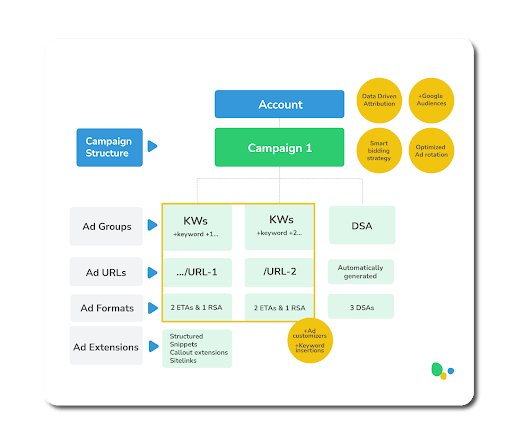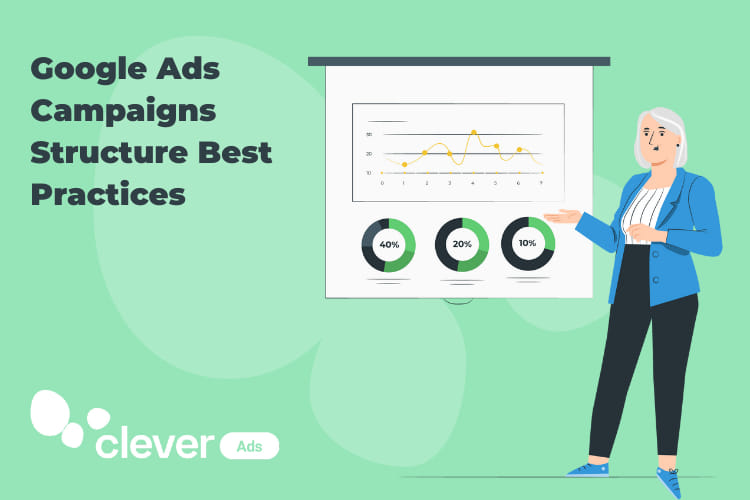Google Ads Campaigns Structure Best Practices
In this post, you’ll learn how to boost your Google Ads campaign performance by applying the best practices for building the right account structure.
Maintaining a consistent and easy structure in your Google advertising strategy is important for making management easier and preventing yourself, or your team, from getting lost in larger Google Ads accounts.
More data equals less volatile knowledge and safer decision-making, but where humans can usually figure out where to find things in an inconsistent structure, the machines have a much harder time. Artificial intelligence works optimally when you follow the three “V”s:
- Volume: Including impression share, conversation volume, etc.
- Variety: Keywords broad match modifier / large and dynamic search ads (DSA), and creativity (ads + extensions).
- Velocity: Real time bidding.
Now that automation and AI are much more prevalent in PPC, what are some new considerations for the perfect structure? Let’s learn how to boost the smart bidding strategies thanks to a modern account structure.
How should your Google Ads campaign structure be?
- Structure the Google Ads campaigns and accounts according to your site content and not your keywords.
- Always use 1 unique URL per ad group.
- Avoid Google Ads campaign segmentation (by device, public, keyword concordancy, etc.)
This way you’ll be able to maximize the number of impressions per ad group, reaching more than 1500 impressions weekly.

- For specific consultations, take advantage of the dynamic search ads so you can guarantee incremental reach and coverage.
- Generate a personalized ad, created dynamically to reflect every consultation and boost performance.
Compared to the average non-brand campaign, DSA targeting generates:
- +35% in CTRS
- -30% in CPCs
- -30% in CPAs
- Link audience lists in observation to all your Google Ads campaigns, because together with the intelligent offers, the audience signals will generate higher performance.
- Guarantee the maximum reach for ad groups oriented by keywords by +2 ETA and +1 RSA. Take into account that adding RSA to ad groups with +2 ETA generates up to +15% of incremental clicks and conversions.
- Deliver relevant ads for each search by inserting mostly broad keywords (Broad / BMM) and ad personalization.
- Make your ads more relevant by using +3 ad extension types. This way you’ll get more clicks at a lower cost with a better ad ranking in the search results pages. Ad extensions generate a CTR up to +15%.
- Adopt an attribution model based on data that reflects your clients flow. Attribution based on data is a personalized model that can boost marketing decisions that are more informed and so a better performance as well.
Time decay and Position-based are other attribution models that guarantee that all the contact points in the client’s flow are considered in their way to perform a conversion.
Finished Google Ads campaigns structure
A complete and modern Google Ads campaign structure should be as follows:

The key elements to adapt to the new consumer behavior are
Key client opportunity |
How Google can help |
|
Prepare for the demand coming back |
Apply the modern account structure strategy |
|
Take advantage of the automatic learning to answer to the demand’s volatility |
Implement automatic offers solutions and keyword coverage to capture demand in real-time |
|
Navigate successfully through the demand’s fluctuations of the consumers |
Adopt a data-based attribution model |
| Adjust your message dynamically to capture the emerging demand and the “new normal” behaviors. |
Use the dynamic search ads (DSA) to capture new searches out of your existing keyword lists. Make sure that the keywords reflect the new trends. |
How to proceed with your Google Ads campaigns
Here is a timeline and the actions you should take into account:
- Preparation: think about the strategy and focus on your client’s objectives.
- Learning phase (1-2 weeks): Activate the strategy and implement “maximize conversions”, “tCPA” or “tROAS”.
- Test (2+ weeks).
- Conversion delay: analyze results.
- Optimization: adjust +/- 15% per week.




